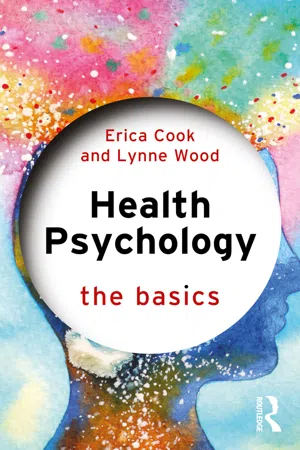
- 258 pages
- English
- ePUB (mobile friendly)
- Available on iOS & Android
About This Book
This accessible primer on health psychology covers the key theories and models of the discipline. Through the use of real-life case studies and examples, it covers a broad range of topics related to the field of health psychology including: health promotion, risky health behaviour and health in healthcare settings. It explains how health psychology serves to not only promote positive health and reduce maladaptive health behaviours, but also support those who are chronically ill.
Unlike medicine, health psychology takes a more holistic approach through the interaction of psychological, social and biological factors to improve health. This book outlines the inter-relationship between how we think and feel, our biological systems and the social contexts in which we live. It discusses how belief and attitude can shape behavior, the pivotal role of stress and how we can adjust to chronic illness. Drawing from experience, the authors answer important and common questions like how can we stop people from smoking? Does stress really make us ill? Why don't people take their medication as prescribed? And how can we support people to adjust to a chronic health condition? It also provides a unique focus on children and adolescent health which considers how developmental changes impact health behaviours and subsequent health.
It is an essential introductory text suitable for students, professionals and general readers interested in this important and emerging topic area. It also provides useful information for those interested in working in the field by providing an overview of what health psychologists do, where they work and the pathways available to become a registered health psychologist.
Frequently asked questions
Information
1
The development of health psychology
Contents
Introduction
Historical approaches to health: a biomedical model of health and illness
Introduction to the biomedical model

Challenging the biomedical view of health

What is health?
I would like to think that I am healthy. I mean I go swimming two mornings a week and like to go on long walks at the weekend. Although, I am probably carrying a bit too much weight, certainly my trousers are feeling a bit tighter than they once did. I eat mostly well, but I can’t resist the tempting puddings when we are eating out on a Saturday. I probably stop at the drive thru café a bit too often, for my regular Chai Latte and a chocolate brownie. Note to self, I should stick to eating more fruit. My alcohol consumption is maybe a bit higher than it should be, a few too many Pinot Grigio’s at the weekend, but it is my down time, that is what I like to say anyway.(John aged 67)
Table of contents
- Cover
- Half Title
- Series Information
- Title Page
- Copyright Page
- Table of Contents
- 1 The development of health psychology
- 2 A bio/psycho/social approach to health and wellbeing
- 3 Attitudes, beliefs and behaviour: Models of health behaviour change
- 4 Health behaviours of children and adolescents
- 5 Stress
- 6 Adjusting to chronic illness
- 7 Health psychology in healthcare settings
- Glossary
- Index